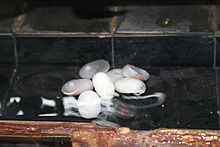Silk construction
Under silk culture or sericulture one understands the whole process of silk production with its components sericulture , cultivation and care of mulberry crops and processing the cocoons to raw silk.
history
Silk construction has its origins in China , where silk was built around 2800 BC. Chr. To have been produced. Today China is the world's largest producer of raw silk. The greatest importance among the silk-spinning insects is the real silk moth ( Bombyx mori L. ). 95% of the natural silk is obtained from this. The fibers from the middle layer of the cocoon of the larvae of Bombyx mori L. are called silk .
Caterpillar breeding
food
The silkworms are monophagous and only eat the leaves of the mulberry trees ( Morus alba and other varieties ). At the beginning of the silk production there is the cultivation of the mulberry trees.
Different species of the mulberry tree can be found on all continents . The evergreen species found in the tropics are growing relatively quickly. The cuttings of new crops are planted in the rainy season . Mulberry plantations are mostly found in monoculture , but there is also the option of mixed cultivation, for example with legumes or maize . For silkworm production it is necessary to keep the trees, which can reach a height of 20-25 m, at shrub height.
The leaf yields of the different species of the mulberry tree show a range of 5–30 t per hectare and year, depending on the site conditions, variety and production system.
development
The silkworm belongs to the group of insects with complete metamorphosis . The life cycle of the silk moth, which, depending on the breed and the influence of environmental factors, lasts about six to eight weeks, has four different stages: egg, larva (caterpillar), pupa and imago . The eggs are obtained from special breeding animals of the silk moth.
The weight of the newly hatched caterpillars does not exceed 0.45 mg. Due to its enormous weight gain of 10,000 times, the chitinized body cover must be thrown off and replaced four times. The period of time between the hatching of the caterpillar and the first moult or between the individual moults is called instar ( larval stage ). By the end of the fifth instar, the filled silk gland accounts for about 40% of the total body weight , the caterpillar is now ready to spin .
Spinning the cocoon
The protein fibroin is formed in two glands on the lower jaw of the caterpillar . These two fibroin strands ( filaments , "brin") are connected by sericine (silk glue), which is formed by two other glands on the lower jaw. Then the silk thread (double filament, "bave") is pushed out of the spinneret at the end of the head. The diameter of a silk thread (“bave”) is around 12–24 µm, wild silk 40–70 µm, the diameter of a single filament (brin) is around 5–10 µm. With this continuous thread, the caterpillar then forms the cocoon by moving its head from side to side. The cocoon hardens when the sericine reacts with the air, the construction of a cocoon takes about 3–4 days, then pupation takes place.
Extraction of the raw silk
The recovery of raw silk is composed of various operations such as harvesting the cocoons, killing the puppet by heat, drying, deflocculating, sorting and boiling the cocoons to soften the sericin and the reeling together (winding the silk threads).
Eight to ten cocoon filaments are coiled together, which then form a single silk thread. Individual cocoon filaments have a length of about 800 m. The production of one kilo of raw silk requires an average of 10–11 kg of cocoons.
Yield and by-products
Depending on the breed, a silkworm has eaten 25–35 g of mulberry leaves in its lifetime. Since silkworms are monophagous , it is possible to relate the cocoon yield to the area. However, this depends on the silkworm breed, the leaf yield of the mulberry tree, the number of leaf harvests, the rearing cycles of the silkworms per year, the amount of eggs used and the yield per egg box. Under favorable conditions in the tropics, up to ten rearing cycles are possible with year-round growth and prosperity of the mulberry trees.
During silk production, large amounts of waste and by-products with very good nutrient contents are created . These can be used in integrated production systems such as animal feeding .
The dolls are used as food insects after the silk has been unreeled .
Bibliography
- Hans Richmart: Practical Guide to Successful Silk Construction , Deutscher Seidenbau-Verlag, Martin Salzmann, Dessau, 1920
Web links
- Yong-Woo Lee, Food and Agriculture Organization of the United Nations: Silk reeling and testing manual. Food & Agriculture Organization of the UN ( FAO ), 1999, ISBN 92-5-104293-4 . Appendix: Illustrations for silk production (English).
- Balance of the silk building with other agricultural and economic uses , 1730, e-book of the University Library Vienna ( e-books on demand )
Individual evidence
- ↑ J.Merritt Matthews, Walter Anderau, HE Fierz-David: The textile fibers: Your physical, chemical and microscopic characteristics , Springer-Verlag, 1928, ISBN 978-3-642-91077-7 , page 198 ff.
- ↑ Franz Weber, Aldo Martina: The modern textile finishing process of synthetic fibers. Springer-Verlag, 1951, ISBN 978-3-7091-2424-6 .
- ^ Paul Heermann: Technology of textile finishing. Springer-Verlag, 1921, ISBN 978-3-662-24954-3 , p. 51.
- ↑ Stephen M. Burkinshaw: Physico-chemical Aspects of Textile Coloration. John Wiley & Sons, 2016, ISBN 978-1-118-72569-6 .
- ↑ Silk facts and figures at swiss-silk.ch, accessed on July 29, 2016.






